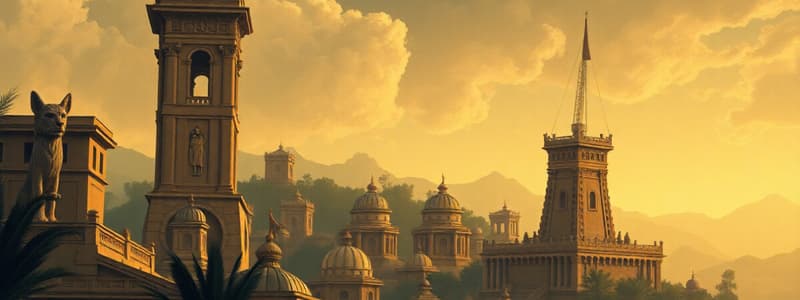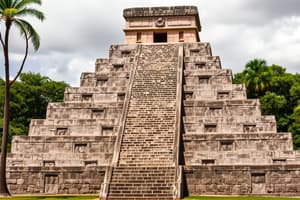Podcast
Questions and Answers
What was the most significant legacy of the Olmec civilization?
What was the most significant legacy of the Olmec civilization?
- Their tradition of priestly leadership (correct)
- Their artistic achievements
- Their agricultural techniques
- Their vast trading networks
Which material did the Olmec famously use for their figurines and carvings?
Which material did the Olmec famously use for their figurines and carvings?
- Granite
- Jade (correct)
- Marble
- Limestone
What types of structures are commonly associated with Maya civilization?
What types of structures are commonly associated with Maya civilization?
- Mud huts
- Towers and skyscrapers
- Wooden cabins
- Stone temples and palaces (correct)
In what significant way did the Sapa Inca govern the Incan empire?
In what significant way did the Sapa Inca govern the Incan empire?
Which of the following best describes the Iroquois League?
Which of the following best describes the Iroquois League?
How did the Nazca culture create their renowned geoglyphs?
How did the Nazca culture create their renowned geoglyphs?
What farming method was commonly utilized by the Maya to adapt to their environment?
What farming method was commonly utilized by the Maya to adapt to their environment?
Which of the following was a characteristic shared by the Maya, Aztec, and Olmec civilizations?
Which of the following was a characteristic shared by the Maya, Aztec, and Olmec civilizations?
What was the primary purpose of the Quipu in the Incan civilization?
What was the primary purpose of the Quipu in the Incan civilization?
What was a unique aspect of Ancestral Puebloan dwellings?
What was a unique aspect of Ancestral Puebloan dwellings?
Flashcards are hidden until you start studying
Study Notes
Olmec Civilization
- Influenced other Mesoamerican civilizations through trade, art, calendar, writing system, and religion.
- The most important legacy was the tradition of priestly leadership and religious rituals.
- Famous for 14 giant stone heads, possibly portraits of rulers, and jade figurines of gods.
Maya Civilization
- Known for towering stone temples, palaces, and monuments called stelae, depicting nobles, warriors, gods, and rulers.
- Developed a hieroglyphic writing system, advancements in astronomy, astrology, mathematics, and counting systems.
- Utilized three calendars: the Long Count for tracking long periods, the Tzolkin for religious events, and the Haab for daily activities and solar years.
- City-states, each with a ruler, often traded with each other, exchanging goods from everyday use to status symbols.
- Farming techniques included controlled fires and raised platforms to combat flooding.
Aztec Civilization
- Tenochtitlan was the capital of the Aztec Empire, known for its wealth generated through taxes during warfare.
- Situated in the Valley of Mexico, surrounded by lakes and high mountains, offering a large surface area and mild climate.
Shared Characteristics of Mesoamerican Civilizations
- Pyramid-shaped temples.
- Ball courts associated with religious rituals.
- Polytheistic beliefs.
- Complex social structures.
- Reliance on agriculture.
- Established armies.
Inca Civilization
- Used Quechua as the official language, which was imposed on conquered peoples to integrate them into their cultural practices.
- The Inca Empire spanned diverse environments, including coastal areas, deserts, high mountains, tropical forests, and jungles.
- The Sapa Inca, the absolute ruler, was considered a divine leader and skilled warrior, controlling politics, military, and expansion.
- Social hierarchy with specific roles and responsibilities for each class, with nobles governing provinces and officials enforcing laws and organizing labor.
Nazca Culture
- Known for intricate geoglyphs, etched into the desert, depicting lines, birds, whales, and other animals that stretch for miles.
- The purpose of these geoglyphs remains debated but may hold spiritual significance.
Moche Culture
- Developed complex irrigation systems and techniques for fertilizing the soil, enabling them to cultivate crops successfully.
Incan Record Keeping
- Used Quipu, a system of knotted strings to communicate, record information and keep track of finances.
- Without a written language, the Inca relied on this intricate system.
Iroquois League
- A union of Native American tribes inhabiting the Great Lakes region, established for peace and alliance among these groups.
Inuit Adaptation to the Environment
- Small bands thrived through hunting and fishing, utilizing sea mammals for food, clothing, and other resources.
- Developed kayaks and dog sleds for transportation and moving goods.
- Built igloos and sod dwellings to adapt to the harsh climate.
Hohokam Culture
- Employed complex irrigation systems and canals to farm in the desert environment of present-day Arizona.
- Their irrigation systems carried river water to distant fields.
- Constructed temple mounds and ball courts, leaving behind significant archaeological remains.
- Descendants of this culture include the Pima and Papago tribes.
Ancestral Puebloan Culture
- Built housing complexes on cliff dwellings within canyon walls, using mud as a building material suitable for arid environments.
- These dwellings offered protection from raiders and were accessed by ladders.
- Created multi-story villages called pueblos, which could house thousands of people, integrated by doorways and ladders.
- They were a vital part of an ongoing cultural tradition.
Mississippian Culture
- Constructed mounds that served as homes for rulers and nobles.
- Worshiped the sun and had powerful rulers.
- Cultivated corn and lived in small homesteads.
- Engaged in trade with other cultures.
Common Theory About People in the Americas
- A land bridge from Asia to North America during the Ice Age is believed to be the primary route for early human migration.
- Some people are believed to have migrated along the West Coast in small boats.
Studying That Suits You
Use AI to generate personalized quizzes and flashcards to suit your learning preferences.




